Inside-Out: An interview with Manjari Sharma and Irina Rozovsky

From The Shower Series, by Manjari Sharma
Last spring, when she got the email from the Metropolitan Museum of Art, photographer Manjari Sharma was surprised. Was the Met really putting on a show of camera-phone art and asking her to participate? Though known throughout the world for its amazing collection of classical art, the Met is not often thought of as an institution on the cutting edge of contemporary art.
But museums must move with the times, and something fresh was brewing at the Met. Curator Mia Fineman had decided to explore what would happen if a group of artists communicated through images alone, making use of the cameraphone’s capacity for instant, fluid exchanges. She chose twelve artists, Sharma among them, and requested that each choose a partner to ‘talk’ to for several months. The artists could post as many images as they wanted to a shared account, but weren’t allowed to type anything to accompany them. Their complete exchange would be exhibited in the show Talking Pictures: Camera-Phone Conversations Between Artists.

From Talking Pictures, by Manjari Sharma
Sharma chose to partner with Irina Rozovsky, whose work she’d gotten to know on Instagram. As it turned out, there was a lot for the two to ‘discuss.’ The 2016 election was coming to its crescendo, and both women were pregnant, due at almost the same time. The combination of political and personal experience was potent.
As the project progressed, Sharma and Rozovsky inspired each other to push into new places, artistically and personally. Sharma had examined others’ vulnerability in her Shower Series and Loss and Resurrection, but had not turned the camera on herself. Rozovsky, whose In Plain Air captured unexpected beauty in Brooklyn’s Prospect Park, describes her work as “transforming external landscapes into interior states”—but like Sharma, she had never done work that felt both so personal and expressive of a political moment.
Talking Pictures: Camera-Phone Conversations Between Artists is on show until December 17, 2017, and features other artist pairs such as William Wegman and Tony Oursler, and Nina Katchadourian and Lenka Clayton. Recently, Sharma and Rozovsky sat down for a conversation with the Literate Lens.
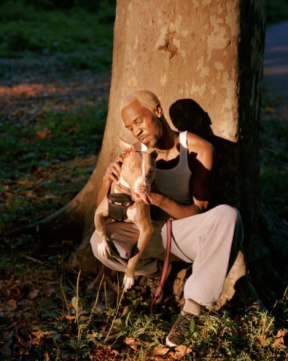
From In Plain Air, by Irina Rozovsky
LL: First of all, Manjari, what made you choose Irina as your partner?
MS: When I got the invitation from the Met, initially I thought about approaching a very famous artist, someone like Shirin Neshat, whose work I adore. But although she has these incredible shows all over the world, she isn’t using her cameraphone as a tool of conversation. And I remembered really enjoying the series Irina did on Prospect Park, and saw how regularly and actively she was posting on Instagram. In retrospect, it could only have been Irina.
LL: How did you decide what this collaboration would focus on?
MS: Well, after I asked her out [laughs]—after I proposed and she accepted—she came to my studio for a visit. We talked about taking on some social issues, like female empowerment and rape culture. Then the project was pushed back by a few months. When we were about to start, I called Irina and said, I just thought I should tell you I’m three months pregnant. And she said, Wow, I have goosebumps. She was in her second trimester! And then, obviously, the conversation changed. It became a lot more personal.
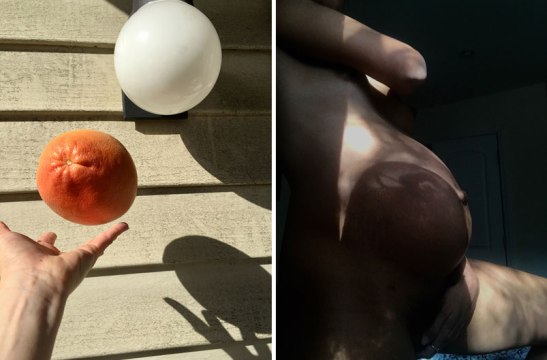
Left, by Irina Rozovsky; Right, by Manjari Sharma
LL: Did the fact that you were both pregnant during the 2016 election influence your visual conversation?
IR: I think it was responsible for the outside/inside elements in the images. We have this little mystery about the outside collapsing, because with pregnancy, there’s always the question of, what am I doing bringing another person into this mess? At the same time, it’s the most sacred process.
MS: It’s so true, I feel like it was really an incredible synchronicity. Inside, things were getting more complex—I was physically getting bigger, and outside, the noise and turbulence were getting larger. I grew, the baby grew and the tensions grew. This project is about a stream of consciousness: there was so much that was happening so quickly that it felt like a constant cycle of birth and death, birth and death. One of us would send an image of something precious and beautiful, and the other one would volley back with something falling apart.
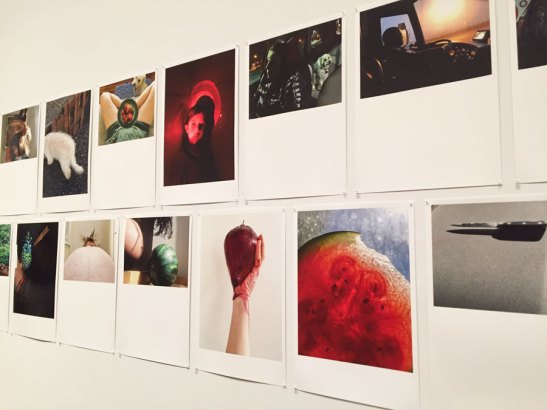
Talking Pictures installation, by Sarah Coleman
IR: There’s so much that’s unknown in pregnancy, so much fear, no guarantee your child will be born healthy. And then this is being mirrored in the bigger picture: the people who are running the country seem like children, and the whole country’s in a fragile, infantile state.
MS: I so agree about the unknown. Having been a mother before, I know that from the time the child leaves your body, its journey of separation begins. And here we’re in such a big ball of the unknown. This project became very comforting to me: there was no full stop on anything, only frequent commas. I would think, I can’t do much about what’s happening to my child or the world, but I can send a photo right now.
LL: Irina, you said in an interview in the New York Times that you wanted to counter the cute-bunnies-and-kittens image of pregnancy, and that you have violence and unease in this series. I’m thinking of one image in particular, of a hand holding up a fruit or vegetable that looks almost like a bloody heart. What was that about?
IR: It was a beet, actually. The idea was of this thing that nourishes us, but also beats. At that time, I was really worried about endangering my fetus, and spent a lot of time at home in the kitchen. So it was about transforming my daily experience into something with more symbolic power. For me, this project was always about the intersection between beauty and pain.
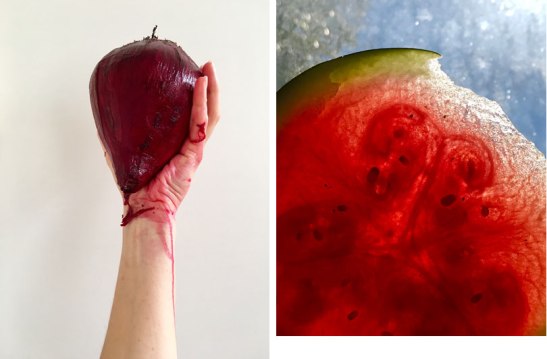
Left, by Irina Rozovsky; Right, by Manjari Sharma
LL: Manjari, you responded with a beautiful but slightly eerie image of a watermelon slice with light shining through it…
MS: I was thinking about the fetus in my body, and there’s that sense of looking through, trying to imagine what my child looks like within me. A little seed in me! I remember eating that watermelon and thinking that there was a plane of understanding between us where, even if we weren’t talking, we were.
LL: How did this exchange compare for both of you with having a text-based conversation?
MS: It was so much more pleasing! Not to take anything away from texts, or the power of words and writing, but I just feel like… it’s like breaking a vase, and you never know how it’s going to break and where the pieces will fall. I was so glad I never knew what Irina would say and what I would say back. It led to so many wonderful clashes and detours. Every time I got a photograph, I was looking at the whole world around me and finding a way to dance back.
IR: I thought it was a good discipline. It felt very clear, very finite, as if we were building a wall together, brick by brick. Conversations don’t happen that way in my house! I’m Russian, and to a non-Russian, a normal Russian conversation sounds like a fight.
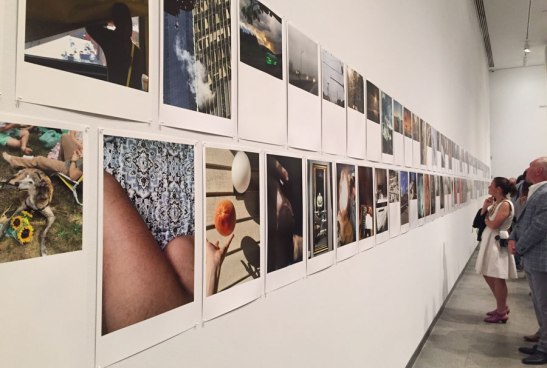
People looking at images at the opening of Talking Pictures, by Sarah Coleman
LL: Were there any times you received an image and thought, what the f— do I do with this?
MS: Well, it felt like a game of poker. Each of us put in our own personal elements, and the other person had to find a way to roll with it. So maybe I’m showing something internal, and she sends back an image shot on the street. And I think, oh, so now we’re doing things on the street.
IR: One time we had this very dramatic thread going, and then I got this very colloquial, happy picture of a girl holding a baby, and I was very confused. I thought, maybe she uploaded it by accident.
MS: And I had! I have another folder I upload to, where I share pictures of my kids, and I uploaded to the wrong folder. The image was exactly what we weren’t making this conversation about—cute bunnies, rainbows and kittens!
LL: Tell me about the exchange where Irina’s image is of a headless male mannequin, and Manjari, you counter with one of your face where your features are blown out by the light.
MS: When Irina sent the image of the mannequin, it caught me off guard. I’d previously sent her a very personal image of my body that addressed an image of hers where she’d had these circular shapes. Then she hit me back with this very interesting image of a headless mannequin.
IR: He doesn’t have a pelvis either. I saw it as the male module to get the pregnancy going. I like having this guy who’s so big and strong, but also truncated and almost powerless—all macho male but not much behind it. And that’s my favorite photo of Manjari’s, because it’s this nameless femininity, her face becomes this egg that’s inseminated by the sperm [in my image] on the left.
MS: I was thinking about how your identity is about to change with the birth of a child. There’s a mystery about who you’ll become.
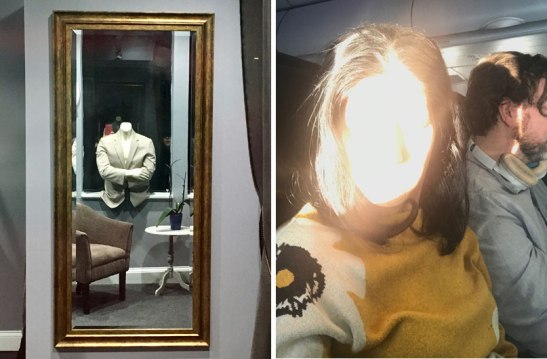
Left, by Irina Rozovsky; Right, by Manjari Sharma
LL: You managed to talk a lot about pregnancy without showing your own bodies that much…
IR: I was pretty adamant about not showing my body. That’s not because I’m shy, I do have a couple of selfies in there because the iPhone really invites that. But I didn’t want it to be just my story. The power is that it’s universal.
MS: I typically don’t point the camera at myself. With this project I did want to point the camera at myself at times. It was challenging. But I was told, take it, own it.
IR: Who said that?
MS: You did! Remember the first photo I texted you? I wanted to appreciate the body and its forms. There’s something about the female body as it grows in pregnancy that I find absolutely incredible. The fact that it expands to accommodate another human. I grew, personally, from being able to document that. In every project, I want to do something I haven’t done before.
IR: I think maybe I would have just photographed flowers forever, but she was texting photos that made it so clear she was pushing herself beyond her comfort zone. And in doing that, she pushed me outside of my known territory for sure.
MS: We pushed each other.
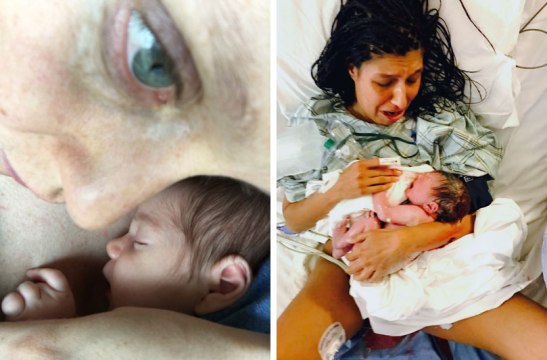
Left, by Irina Rozovsky; Right, by Manjari Sharma
LL: Are you addicted now, will you go on communicating this way?
MS: Definitely it got to be a bit of an addiction, we got used to the volleying back and forth.
IR: It felt like it could go on forever. It reminds me of that film Boyhood. What we created for the Met was just one chapter.
MS: Our babies were born. I’m excited to see glimpses of their lives as they go on. Whatever the gap between the chapters is doesn’t really matter—it would just be cool to have this two-way mirror as they grow up.
2 comments on “Inside-Out: An interview with Manjari Sharma and Irina Rozovsky”
Leave a Reply
Connecting to %s


I’ve been considering taking a vow of silence for some time now and it’s still on the table, but I also think this is such a unique and revealing way to communicate that I might just have to find a friend to try it out with. I absolutely love the watermelon with it’s swirls and seeds. Being a mother, I’m fascinated by the whole process of transformation that takes place inside. What a new take on an old subject.
Fascinating stuff.